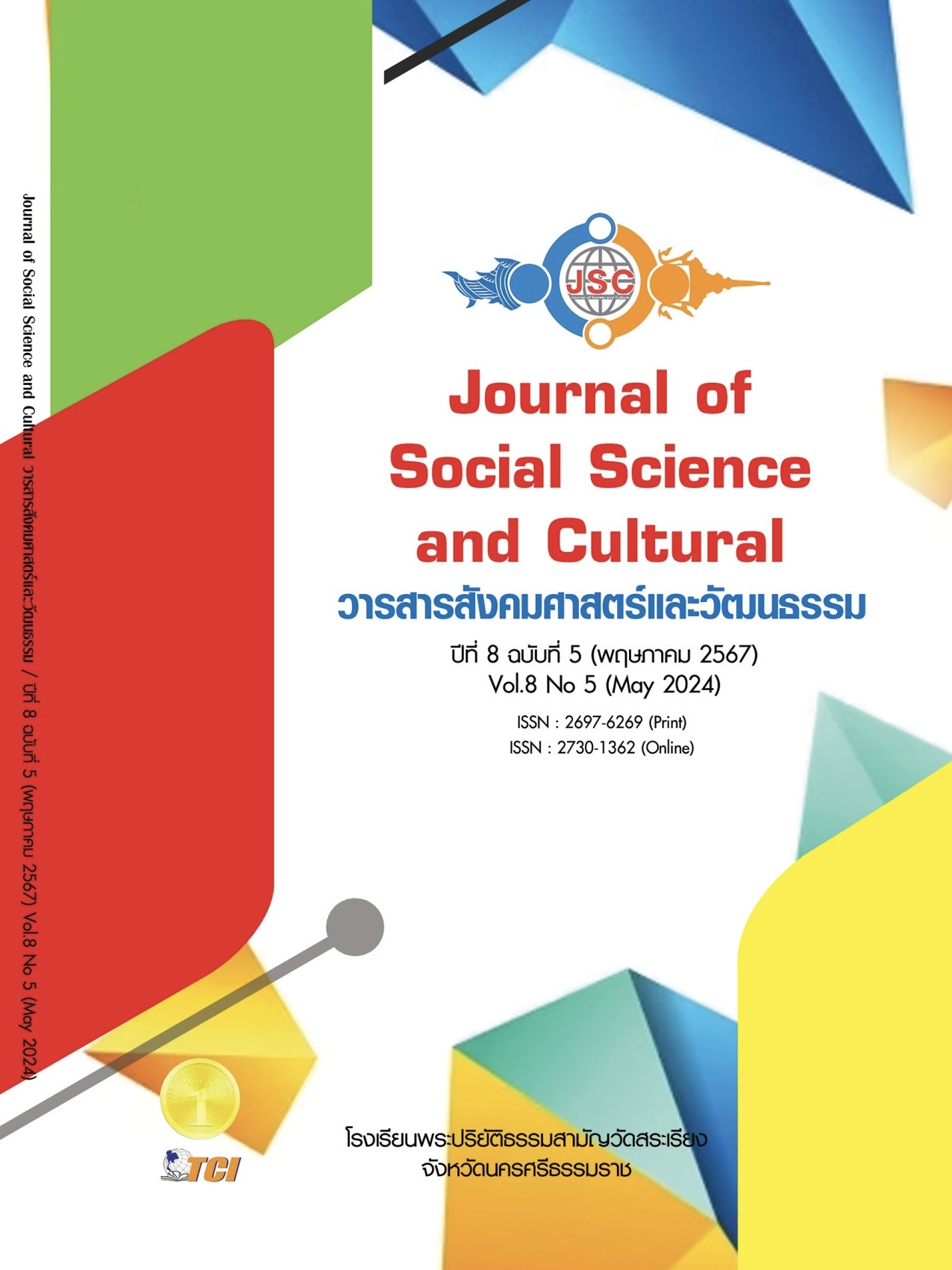ANALYTICAL READING DEVELOPMENT APPLYING STANISLAVSKI’S SYSTEM FOR UPPER PRIMARY STUDENTS
Main Article Content
Abstract
The purposes of this research were to: 1) it aims to thoroughly examine the potential of the Stanislavski’s system in enhancing the organizational process of fiction learning activities. And 2) it seeks to confidently evaluate the impact of implementing the Stanislavski’s system on the analytical reading skills of upper primary school students during fiction learning activities. The investigation was conducted on a group of 5th-grade students from a demonstration school that falls under the purview of a state-run university in Bangkok. The sample size consisted of 78 students, equally divided into an experimental group and a control group, each comprising 39 individuals. The research methodology involved both pretest and posttest evaluations to students in both the experimental and control groups to measure their analytical reading ability. The instructional plan for the experimental group is fiction-based learning activity by using the Stanislavski’s system while the control group was provided with an instructional plan for organizing regular learning activities. The data were analyzed using arithmetic mean, standard deviation, and t-test. The research findings were as follows: 1) The process of organizing fiction-based learning activities for upper primary school students by using the Stanislavski’s system. The approach involves five key steps, namely: 1.1) Thoroughly analyzing the theme based on the composition; 1.2) Analyzing the background and motivation of the characters; 1.3) Establishing scene imagination and analyzing the influence of the scene; 1.4) Analyzing the essence of the story; and 1.5) Connecting the experience with the theme. And 2) The mean scores of students in the experimental group for analytical reading ability were found to be significantly higher than those of students in the control group after organizing learning activities. This statistical was observed at the .05 level of significance. Additionally, the mean score of students in the experimental group for analytical reading ability after organizing the learning activities was significantly higher than their score before organizing the activities, with statistical at the .05 level of significance.
Article Details
References
กระทรวงศึกษาธิการ. (2551). หลักสูตรแกนกลางการศึกษาขั้นพื้นฐาน พุทธศักราช 2551. กรุงเทพมหานคร: กระทรวงศึกษาธิการ.
กฤษณะ พันธุ์เพ็ง. (2560). Stanislavski and I: เมื่อเราเข้าใจกัน. เรียกใช้เมื่อ 11 มีนาคม 2566 จาก https://medium.com/@g.punpeng/stanislavski-and-i-เมื่อเราเข้าใจกัน-c561bc4c0729.
กุหลาบ มัลลิกะมาส. (2525). ความรู้ทั่วไปทางวรรณคดีไทย. กรุงเทพมหานคร: โรงพิมพ์มหาวิทยาลัยรามคำแหง.
บรรเทา กิตติศักดิ์. (2542). ภาษาไทยเพื่อการสื่อสาร. กรุงเทพมหานคร: มหาวิทยาลัยเกษตรศาสตร์.
ยุวพาส์ ชัยศิลป์วัฒนา. (2544). ความรู้เบื้องต้นเกี่ยวกับวรรณคดี. กรุงเทพมหานคร: สำนักพิมพ์มหาวิทยาลัยธรรมศาสตร์.
ราชบัณฑิตยสถาน. (2560). พจนานุกรมศัพท์วรรณกรรม ฉบับราชบัณฑิตยสถาน. กรุงเทพมหานคร: ราชบัณฑิตยสถาน.
วัชรี บูรณสิงห์ และนิรมล ศตวุฒิ. (2542). การอ่านเชิงวิเคราะห์วิจารณ์ด้านหลักสูตรและการสอน. กรุงเทพมหานคร: สำนักพิมพ์มหาวิทยาลัยรามคำแหง.
ศุภณัฐ พานา. (2560). การพัฒนารูปแบบกาเรียนการสอนประวัติศาสตร์ตามแนวคิดกระบวนการสืบสอบ แสวงหาความรู้เป็นกลุ่มร่วมกับแนวคิด Magic If เพื่อส่งเสริมทักษะการคิดทางประวัติศาสตร์และการรับรู้ความรู้สึกทางประวัติศาสตร์ของนักเรียนระดับชั้นมัธยมศึกษาตอนปลาย. ใน วิทยานิพนธ์ครุศาสตร์
มหาบัณฑิต สาขาวิชาหลักสูตรและการสอน. จุฬาลงกรณ์มหาวิทยาลัย.
สถาบันทดสอบทางการศึกษาแห่งชาติ (องค์การมหาชน). (2565). รูปแบบข้อสอบ และจำนวนข้อสอบในแต่ละรายวิชา (Test Blueprint) วิชาภาษาไทย. เรียกใช้เมื่อ 20 พฤษภาคม 2566 จาก https://www.niets.or.th/uploads/editor/files/O-NET/61_65_Thai_P6_web.pdf
สมพร จารุนัฏ. (2538). คู่มือการเขียนเรื่องบันเทิงคดีและสารคดีสำหรับเด็ก. กรุงเทพมหานคร: โรงพิมพ์คุรุสภาลาดพร้าว.
อัมพร สุขเกษม. (2542). การอ่านหนังสือ. กรุงเทพมหานคร: มหาวิทยาลัยศรีนครินทรวิโรฒ.
Adler, M. J. & Doren, C. V. (1972). How To Read A Book. United States of America: Touchstone.
Allen, D. (1999). Stanislavski for beginners. United States of America: Writers and Readers: Inc.
Hapgood, E. R. (1964). An Actor Prepares. New York: Routledge.
Kelly, E. (1973). The Magic If: Stanislavski for Children. Maryland: National Educational Press.
Powell, M. (2010). The Acting Bible. London: Quintet Publishing.


